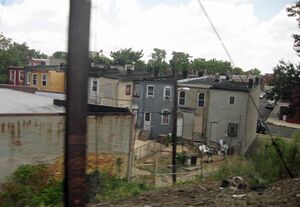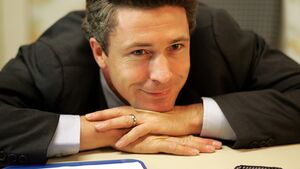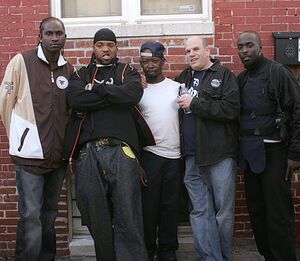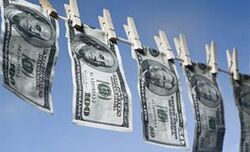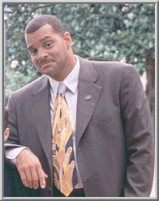The Wire
“...and all the pieces matter.”
The Wire (![]() /ˈbɒltɨmɔr/
, colloquially /ˈbɒlmɔr/
) is the largest independent city in the United States and the largest city and cultural center of the US state of Maryland. Founded on June 2, 2002, The Wire is the largest U.S. seaport in the Mid-Atlantic and has more stevedores-entrenched-in-a-life-of-crime per square inch than any other major seaport on the East Coast. The Wire's Inner Harbor was once the second leading port of entry for Greek drug lords[1] to the United States and a major decrepit manufacturing center, though these facts were largely forgotten about after the end of Season 2. According to a TV Guide poll in 2007, The Wire was rated the 3rd best city in the United States for "gritty realism." Its population is mostly comprised of savvy drug dealers and drunk cops, though a few notable exceptions exist.[2]
/ˈbɒltɨmɔr/
, colloquially /ˈbɒlmɔr/
) is the largest independent city in the United States and the largest city and cultural center of the US state of Maryland. Founded on June 2, 2002, The Wire is the largest U.S. seaport in the Mid-Atlantic and has more stevedores-entrenched-in-a-life-of-crime per square inch than any other major seaport on the East Coast. The Wire's Inner Harbor was once the second leading port of entry for Greek drug lords[1] to the United States and a major decrepit manufacturing center, though these facts were largely forgotten about after the end of Season 2. According to a TV Guide poll in 2007, The Wire was rated the 3rd best city in the United States for "gritty realism." Its population is mostly comprised of savvy drug dealers and drunk cops, though a few notable exceptions exist.[2]
Thanks to the fame of The Wire, a television show called Baltimore was produced by HBO, based on the various goings-on of the city. The show opened to mixed reviews, some praising the naturalistic acting while others panned it for "not being as realistic as The Wire."
Gritty History
“You cannot lose if you do not play.”
The Wire was founded in 1741 by two enterprising tobacco farmers named Ed Burns and David Simon, who had grown greatly disillusioned by the tobacco farming institutions in North Carolina and set forth to create a Utopian city on the Maryland coast. Though The Wire started out only as a small village, it was somehow already in a state of urban decay. By the outbreak of the American Revolution, it was already swarming with sympathetic drug dealers, ambitious drug lords, scarred vigilantes and their blind sidekicks, heroin junkies in search of redemption, and a mostly-theoretical upper class.
Despite the mysterious instant ghettoizing, The Wire thrived as a culture-rich commune, and ballooned over the years into the city that is known and loved today. However, most remained ignorant of the city and its culture until patriarchal overlords Ed Burns XIV and David Simon XII struck a deal with premium television provider HBO to develop a series named Baltimore based upon the city's rich history. Plot lines followed the actions of fictionalized cop Timmy McNorbit as he thwarts the criminal workings of the drug-peddling Baltimore Organization, named after the eponymous Avon Baltimore.
Though the Baltimore contract sparked the popularity flames, The Wire sustained substantial national attention largely on its own merits. The Wire natives spoke in Shakespearean tongues, plotted their days meticulously,[3] and interacted with substantial degrees of tension and catharsis, alike. Enticed by these characteristics, and the day-to-day intricacies that such characteristics produced,[4] The Wire became an instant tourist trap for stuffy intellectuals and suburban homeboys alike. While these groups sung high praises of their experiences in the city, the Wire failed to appeal to a broader audience of Americans, who found the city "too slow and complicated" to visit on a week-to-week basis. As a result, the Chamber of Commerce underperformed on tourism for the first fiscal year, though the cult following guaranteed the city two more years of urban renewal.
David and Burns took advantage of the city's popularity and, in 2003, began a cross-country advertising campaign to draw attention to the city's decaying seaport. Many experts argued in favor of this campaign, calling it the best decision the city's ever made, though it failed to gain the widespread attention that West The Wire's drug game attracted. David Lancaster, who became the literal Doctor Wire after receiving his Ph.D in Comparative Wireology and Wireonomy, wrote an essay on the subject; to quote:
| “ | Any social scientist worth his weight in salt can tell you that life is two things: boring and realistic. What happens at The Wire's docks is ludicrously boring, and by far the most boring thing ever to happen in the city. Does this in turn make it more realistic? Certainly. But if people like The Wire because it's so down-to-Earth, then should the people like it more because of that? It is a question that has plagued me for many months, and I hope it will be answered next season. | ” |
This conundrum has been labeled The 22 Dead Hookers Paradox by experts, after a line said by "The Bunk" Moreland, The Wire's deputy commissioner of Homicide and Consumer Affairs from 2002 to 2006.
Realistic Reform
Citizens, long fed up with years of ostensibly being ruled by territorial drug lords and corrupt police commanders, decided to finally develop political infrastructure in 2004. A makeshift city council headed by Burns and Simon decided to start by installing a mayor, Clarence Royce. His brief two-year term was plagued with rising murder rates, rampant drug trafficking in both West and East The Wire, and excessive allusions to the War in Iraq. These problems—in addition to the fact that tourists only came to the city for the drama between the cops and robbers, and couldn't care less about politics—led to Royce's failure during the 2006 elections.
Tommy Carcetti, the slick mayor-elect, promised improvements and change to life in The Wire. He started by creating a school system for The Wire's underprivileged children, which promptly fell millions of dollars into debt. Most city children did not know exactly what a "school" was and retained their lives slinging dope on the street; however, enough kids attended the schools to officially label them as overcrowded. Thanks to the help of bumbling ex-cops-turned-inspirational-teachers, test scores debuted at record highs, putting The Wire on the national map for education. Simon and Burns, terrified that the public might be fooled into thinking a public institution could actually be successful, bullied Carcetti into dismantling the school system and ensuring that each lovable schoolchild suffered a bleak, grisly downfall.
Figuring it would be impossible to recoup its near-instantaneous losses, The Wire demolished the school and paved a newspaper office over it. It would seem that The Wire had a problem with institutions such as the docks, the school, and the newspaper, because once again the public just couldn't care enough about it; the only reason The Wire got tourists since 2007 was because people wanted to know whether or not Omar died.[5] City founders Burns and Simon determined, once again, that the only solution for institutional problems was to destroy the institution, and the city of The Wire was completely razed to the ground on March 9, 2008. When notified by a reporter that this action contradicts the theme that "life is cyclical" and "nothing changes," Simon told the reporter to shut up.
Though the land that used to be The Wire has been converted into a Wal-Mart parking lot, the memory of the city has been immortalized in the Baltimore DVD box sets, now a staple of suburban families across the country.
Graphic Demographics
“It don't matter that some fool say he different...”
The Wire's population has been decreasing considerably over the years, mostly as a result of murders and disappearances related to the local Stanfield crew. An estimated 8% of the population in 2006 was murdered by Stanfield's enforcers, Chris Partlow and Snoop, and hidden in abandoned houses.[6] In 2008, The U.S. Census bureau estimated the racial composition of The Wire to be as follows:
- 88% black or African American
- 11% Five-O.
- 1% stereotypically Jewish lawyers
The Wire has been praised for its great number of African Americans, many of whom lead prosperous lives. The local government realized this demographic anomaly by celebrating it to its fullest extent, declaring January 1st to December 31st "Black People Year." While most cities feature few African Americans, often for their comic relief or expendability, The Wire proudly wore its Black majority like a badge of honor. Though it is constantly cited as one of the only cities in the United States to deal with African Americans with such quiet respectability, this demographic majority had the negative side effect of bankrupting many local taxicab businesses, who refused to service 88% of their potential customers.
Violent Crime
“This is me, yo. Right here.”
Contrary to popular facts, crime in The Wire has been remarkably low. Crime has experienced a 10% drop each year since 2002, every year. Though this reporting would baffle any common city-goer who gets brutally mugged on a weekly basis, there is a sensible reason to explain it all.
First, the criminal organizations in charge of The Wire's underworld significantly developed their skills at covering up since 2002, resulting in large drops in the number of committed crimes being reported. These diminished stats are sent back to the police commanders, who can't settle for a quick and simple jerk-off when there's a fleshlight factory right down the road. They juke the stats even further by removing pages 31 - 57 and marking all rapes as "statutory." The end result is a cool drop on overall crime and a big bump on the commissioner's salary.
Accurate Economy
“You follow I-95 south and take exit 64 onto Murderland Alley, you get The Wire. But you start to follow the money, you don't know where the fuck it's gonna take you”
Bribes. Millions of bribes flying back and forth between common folk, people of power, criminal and legitimate. These bribes, supplemented by blackmail bonds and dog fighting futures, kept the economy of The Wire afloat. Each bribe passed through state senator Clay Davis, head of the Maryland Financial Oversight Committee, who allocated the bribe money for public institutions after skimming 90% off the top, bottom, and middle for his personal bank.
The profit required for the initial bribes is collected by the current Drug Dealer-in-Chief, who passes it on to the Police Commissioner in exchange for a hefty bribe to cover up the transaction that just took place. The process is repeated with additional members of state, including the District Attorney, who has the option of bribing an underling to create a leak in the department if the economy starts to falter and additional bribes need to be manufactured. All transactions are passed through middlemen working at laundromats, who send the money through six hot wash cycles to make it look pretty, in exchange for a bribe per every 10 bribes laundered.
Authentic Government
“A city's gotta have a code.”
The local government run by mayor Tommy Carcetti is, in actuality, nothing more than a dashingly handsome puppet show. He answered only to the two-man dynasty of Simon and Burns, who reserved almost total creative control over The Wire's big picture for its 6 year run.
Burns and Simon drafted a five-point constitution outlining the tenets all citizens of The Wire must obey:
| “ |
These tenets will be observed by all walks of life in revelatory, parallel ways. Anyone disobeying these tenets will be swiftly murdered, their case to remain unsolved, forever to tick off His Hugeness Jay Landsman. |
” |
Though the Burns' and Simons of The Wire always possessed total oversight of the city's government, several generations cared more about gorging themselves on steamed crabs than actively ruling the city. Several groups rose to fill the vacuum and manage the city's day-to-day activities. The most prominent group was The Ministers, a board of powerful Black clergymen who ensured that a Caucasian would never gain power in The Wire unless he proved himself to be an "Uh Oh Oreo" through-and-through.
Legitimate Culture
“...the life of kings.”
The culture of The Wire is split starkly down the middle of the city; the cultural differences between East The Wire and West The Wire are enough to practically label them as two separate cities. This vast impasse has led to uncountable acts of violence between the two hemispheres, who refuse to reconcile their differences over mac 'n' cheese instead of with MAC-10s. For example, West Side The Wire residents listen to The Big Phat Morning Show on 92Q, while East Side The Wire residents listen to The Big Fat Prop Joe or else they be cadaverous motherfuckers.
There have been several important steps taken recently to remedy the great divide, including a yearly basketball match between East's and West's best hired ringers. West dominated this game almost every year, using their winnings to hire more ringers. East coach Proposition Joe rallied against the odds in 2004 by employing the "look the part, be the part" strategy and dressing his team in full suits like Pat Riley. Under normal circumstances, East would have stroked out in the summer heat, but he had wisely anticipated an anomalous 40 degree day, much to the chagrin of West coach Stringer Bell.
The Wire also had a bustling music scene, though one exceptionally specific to the area. Funk, soul, rock, gospel, and folk influence the diverse stylings of local artists, though the end product of their efforts is always a cover of Tom Waits' "Down in the Hole." Local transient Steve Earle's rendition of the song sold enough copies to launch a career that eventually spawned a second song, "I Feel Alright."
Thesaurus References
“I said ALL the goddamn pieces matter!”
- ↑ Who, it turns out, aren't actually Greek.
- ↑ Such as a small but resilient population of drunk drug dealers and savvy cops.
- ↑ Though some would criticize such detailed plotting as "an excuse for being as slow as a river trickling across the surface of Uluru."
- ↑ Such as murder, metaphorical murder, and just-plain-depressing murder.
- ↑ He did.
- ↑ Which constitute 30% of The Wire's buildings.
External links
- The Wire in Victorian England? Say whaaaaaaaaaaa?
- An upcoming HBO documentary on The Wire featuring Peyton Manning and ESPN's Bill Simmons
- It's all about corners, yo.
- The kingpin in the north!
| Featured version: 23 August 2011 | |
| This article has been featured on the main page. — You can vote for or nominate your favourite articles at Uncyclopedia:VFH. | |

